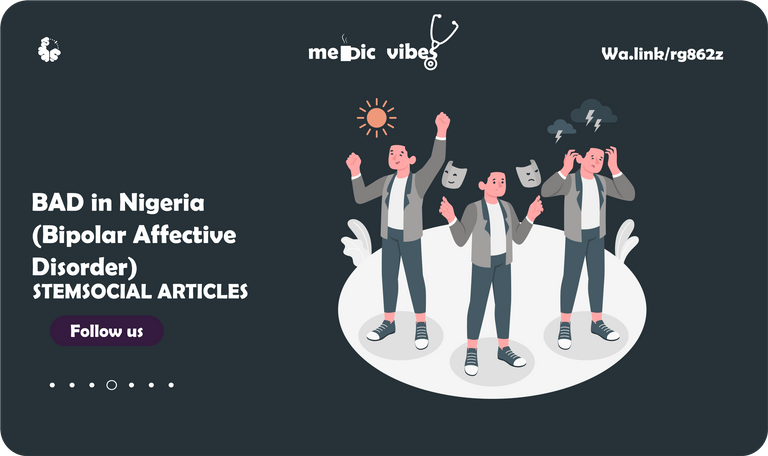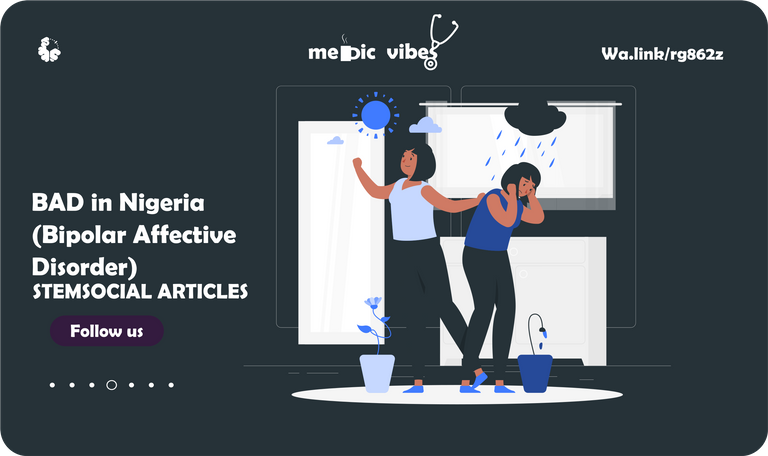BAD in Nigeria 3/7(Results)

In the last post, we found that there was no sexual preference as a whole in BAD. We found that type I could affect children from the age of 5. We also found that episodic treatments are more reliable than treatment of the whole condition.

Inkscape.org
Depression vector created by pch.vector - www.freepik.com and Inkscape.org
Welcome to Medic Vibes, a place where we discuss and make sense of mental health disorders. My name is Dr Ebingo Kigigha, and I am a medical doctor (aspiring psychiatrist) and creative individual (illustration and music). We have been doing this for two months in a row. This month will be dedicated to Bipolar Affective Disorder, or BAD for short. The first month we discussed Depression, and the following month we discussed anxiety. As we did two months ago, we will begin with a discussion of a study. So far we have introduced the study and talked about previous studies done to outline the peculiarities of Bipolar Affective Disordconditionshis post, we will be continuing with the talk about the study. This study was done in Enugu Nigeria. Enugu is a state in Easter Nigeria with a population of about 820 thousand people. Today we will be discussing the results of the study from the demographic to the types of conditions in BAD and how they first presented themselves.

Patients who are bipolar have these major depressive episodes and manic episodes. Mood disorders are also called affective disorders 2 months ago, we talked about depression, among the types of depression is Major Depressive Disorder which is otherwise known as unipolar depression.

History

Top Left King Saul, Top Right Hippocrates Bottom Left Robert Burton Bottom Right Anatomy of Melancholy
King Saul's features in the bible, were typical of mood disorders when he would have David play for him in his palace. Hippocrates believed depression was a result of black bile and he called it Melancholic (meaning Black Bile). The first person to describe depression in English text was done by Robert Burton. His book Anatomy of Melancholy dates back as far back as 1621. Emil Kraepelin developed the criteria that is still used for manic-depressive psychosis. It was called folie circularie.
Demographics
Among all the mood disorders BAD I has the earliest onset. The prevalence of BAD I is equal in men and women. Episodes of mania are seen more in men while depressive episodes occur more in women. Depression appears to have a higher occurrence in rural areas, there is a tendency for schizophrenia to be misdiagnosed by practitioners from a different culture from the patient.
Other Associated Conditions
People who deal with mood disorders are significantly at risk of dealing with alcohol abuse or dependence, anxiety disorders particularly panic, obsessive-compulsive and phobias, particularly for people and socialising. In the same manner, those who use illicit substances and abuse alcohol put themselves at risk of mood disorders. Women particularly have eating disorders when they go through unipolar and bipolar disorders.
People who are Bipolar when compared to those who have unipolar conditions are more likely to abuse substances. In Epidemiological studies, those with bipolar mood disorders were more likely twice the time to abuse substances and have anxiety disorders: Panic and OCD than unipolar mood disorders.
Having substance abuse problems significantly worsens the chances of the patient getting better and increases the chances that they might commit suicide.
Cause of Mood Disorders
Studies have shown a difference in the biology of those who suffer from mood disorders. Many eyes have been on the monoamines such as serotonin and norepinephrine when trying to come up with explanations for the peculiarities of this condition. A gradual change in focus to the neurobehaviour, the systems involved, neural circuits and the regulation of these systems. The new line of thinking is that the disturbances in the neuro amine are only seen after a more direct cause takes place.
The Amines
Among the biogenic amines, the names more likely to be brought up as related mood disorders are serotonin and Norepinephrine.
Regarding Nor epinephrine what scientists know about the neuro amine is because the reaction the body has to antidepressants such as Venlafaxine cause modulates the concentration and effect of the neurotransmitter at the synaptic cleft. Activation of the surface receptors before the neuronal synapse in depression also reduces the concentration of norepinephrine. Another proof of its effectiveness is the effect of don regulation of the hormone.
Similar to Norepinephrine the use of drugs that modulate the concentration of Seratonine has also been factored into the cause of mood disorders. The drug class in Seratonin Reuptake inhibitors affect the reuptake at the synaptic cleft to this neurohormone.
Additional data concerning serotonin's effect on mood disorders is seen when the Cerebro Spinal Fluid of suicidal individuals is analysed. There is evidence of low serotonin metabolisation products.
In an experimental context, nor epinephrine serotonin is mostly mentioned but dopamine has been theorised to have a part to play. This is because dopamine can reduce depression and increase mania. There is also a new subtype of dopamine and also the regulation mechanisms of dopamine are still being understood. Another reason why dopamine is being watched is because of certain drugs and diseases that reduce its concentration present with depression. Oppositely also, drugs and diseases that increase their concentration reduce depressive symptoms.
Two students are ongoing about the effect of dopamine including those on the mesolimbic pathway and the D1 receptors.

Results

People illustrations by Storyset
Statistically, there were 94 subjects in this study, Of these 94 people, 55 of them were men who made up 58.8% and the remaining 39 were women who were 41.5%%. The patients were between the age of 12 to 74. The mean of their age was 33.7 years and the standard deviation was 11.87. Those less than 15 years were just 2 while those above between the age of 15 to 24 were the second highest with 17 participants falling within this group, the age 25 to 34 made up 1/3 of each participant.
Age 45 to 54 had 9 participants, age 55 to 64 and 65 above both had 3 participants.
67 (a majority) of the 94 participants were single, only 4 were widowed, separated or divorced while the rest (23) were married.
Of the patients examined, only one was uneducated, 13 had less secondary schooling education, 32 were done with secondary school and 46 were educated above secondary schooling.
40 were employed while 34 were unemployed.
Diagnostic Features
Age at the start of the illness was found to have a mean of 22.9 years. 17 of the patient did not have a particular type of BAD. Of the others, 2/3 were in the DSM for type 1 while 1/3 were type 2.
The first mood symptom among 63 of them was an elevated mood 20 were depressed while the rest had a mixed presentation. At the beginning of this study, 28 had an elevated mood, 16 were depressed and 4 had a mixed presentation. About half (43)of them did a normal (euthymic) mood.

Tips
The decision to place a patient under hospital supervision is the most important choice to be made by the physician. This usually weighed against the risk of outpatient treatment. The Risk of suicide or homicide is at the top of the list of indications for hospitalization of the patient. Another is if the basic necessities such as food and shelter are not attainable for the patient. The last reason for hospitalisation would be if an investigation needs to be done.
A patient whose symptoms are uneasy to control and usually losses the support of his or her loved ones is also a factor to consider.
Case of hypomania or mild depression can be managed on an outpatient basis, especially if there is no weight loss, impaired judgement and insomnia. For this, to work the loved ones of the patient have to show commitment to helping the patient. It is important to stress to loved ones the need to manage the condition in the hospital if there are changes in the patient's behaviour.
If a patient has a mood disorder at a time, decisions have to be made for them this is because of the slow rate of thought that is associated with these conditions, negative worldview (Weltanschauung) and despair. Those who are manic will consider it abnormal that they are being hospitalised, this is how disassociated from their condition they can be.

Hive Stories
@stemsocial's very own @oluwatobiloba explains in detail mental health conditions as a whole, bringing to light how complicated they can be. Read more about this post here
Questions
- What did you learn about mood disorders?
- What did you learn about Bipolar disorder?
- What's the most interesting aspect of this study?
Conclusion
The neurotransmitters that were found to be related to BAD so far were Serotinine, Norepinephrine, and Dopamine. There were more males in the study than females. Patients younger than 15 were included in the study and those above 65. More patients in the study had a normal mood at the time of the study.

I hope that you learned a lot from this post.
To book me for illustration gigs click Here
References
- Kaplan-Sadocks-Comprehensive-Textbook-Psychiatry
- Psychiatria
- Page demarcations made with Inkscape.org
I feel honored for the mention @ebingo, thanks a lot. Mental health conditions are a great deal and they should never be taken for granted.
Veryt true. Thank you for stopping by.
Thanks for your contribution to the STEMsocial community. Feel free to join us on discord to get to know the rest of us!
Please consider delegating to the @stemsocial account (85% of the curation rewards are returned).
You may also include @stemsocial as a beneficiary of the rewards of this post to get a stronger support.